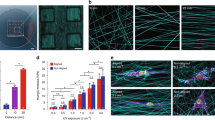Abstract
We present here the first quantitative correlation for cell contact guidance in an oriented fibrillar network in terms of biased cell migration. The correlation is between the anisotropic cell diffusion parameter,D A=Dx/Dy, and the collagen gel birefringence, Δn, a measure of axially biased collagen fibril orientation in thex-direction. The cell diffusion coefficients,D x andD y, measure the dispersal of cells in the directions coincident with and normal to the axis of fibril orientation, respectively. Three essential methodological components are involved: (i) exploiting the orienting effect of a magnetic field on collagen fibrils during fibrillogenesis to systematically prepare uniform axially oriented collagen gels; (ii) using a microscope/image analysis workstation with precise, computer-controlled rotating and translating stages to automate birefringence measurement and, along with rapid “coarse optical sectioning” via digital image processing, to enable 3-D cell tracking of many cells in multiple samples simultaneously; and (iii) employing a rigorous statistical analysis of the cell tracks to estimate the magnitude and precision of the direction-dependent cell diffusion coefficients,D x andD y, that defineD A. We find that this measure of biased migration in contact guidance (D A) increases with increasing collagen fibril orientation (Δn) due mainly to a rapid enhancement of migration along the axis of fibril orientation at low levels of fibril orientation, and to a continued suppression of migration normal to the axis of fibril orientation at high levels of fibril orientation.
Similar content being viewed by others
References
Barocas, V.H.; Tranquillo, R.T. Biphasic model andin vitro assays of cell-fibril mechanical interactions in tissueequivalent gels. In: V.C. Mow, ed. Cell mechanics and cellular engineering. Springer-Verlag: New York; 1994.
Dickinson, R.B.; McCarthy, J.B.; Tranquillo, R.T. Quantitative characterization of cell invasionin vitro: formulation and validation of a mathematical model of the collagen gel invasion assay. Ann. Biomed. Eng. 21:679–697; 1993.
Dickinson, R.B.; Tranquillo, R.T. Optimal estimation of cell movement indices from the statistical analysis of cell tracking data. AIChE J 39:1995–2010; 1993.
Dickinson, R.B.; Tranquillo, R.T. A stochastic model for adhesion-mediated cell random motility and haptotaxis. J. Math. Biol. 31:563–600; 1993.
Dunn, G.A. Characterising a kinesis response: time averaged measures of cell speed and directional persistence. Agents Actions Suppl. 12:14–33; 1983.
Dunn, G.A. Chemotaxis as a form of directed cell behaviour: some theoretical considerations. In: Lackie, J.M.; Wilkinson, P.C., eds. Biology of the chemotactic response. Cambridge University Press: Cambridge; 1981: pp. 1–26.
Dunn, G.A. Contact guidance of cultured tissue cells: a survey of potentially relevant properties of the substratum. In: Bellairs, R.; Curtis, A.; Dunn, G., eds. Cell behaviour. Cambridge University Press: Cambridge; 1982: pp. 247–280.
Dunn, G.A.; Brown, A.F. A unified approach to analysing cell motility. J. Cell. Sci. Suppl. 8:81–102; 1987.
Freshney, R.I. Culture of animal cells: a manual of basic technique, 2nd ed. Alan R. Liss, Inc.: New York; 1987.
Furth, V.R. Die Brownshe Bewegung bei Berucksichtigung einer Persistenze der Bewegungsrichtung. Mit Anwendungen auf die Bewegung lebender Infusorien. Zeit. f. Phys. II:244–256; 1920.
Gail, M.H.; Boone, C.W. The locomotion of mouse fibroblasts in tissue culture. Biophys. J. 10:980–993; 1970.
Guido, S.; Tranquillo, R.T. A methodology for the systematic and quantitative study of cell contact guidance in oriented collagen gels: correlation of fibroblast orientation and gel birefringence. J. Cell. Sci. 105:317–331; 1993.
Harris, A.K. Tissue culture cells on deformable substrata: biomechanical implications. J. Biomech. Eng. 106:19–24; 1984.
Harris, A.K.; Stopak, D.; Wild, P. Fibroblast traction as a mechanism for collagen morphogenesis. Nature 290:249–251; 1981.
Haston, W.S.; Shields, J.M.; Wilkinson, P.C. The orientation of fibroblasts and neutrophils on elastic substrata. Exp. Cell. Res. 146:117–126; 1983.
Heath, J.P.; Hedlund, K.-O. Locomotion and cell surface movements of fibroblasts in fibrillar collagen gels. Scan. Electron Microsc. 4:2031–2043; 1984.
Inoue, S. Video microscopy. Plenum Press: New York; 1987.
Matthes, T.; Gruler, H. Analysis of cell locomotion. Contact guidance of human polymorphonuclear leukocytes. Eur. Biophys. J. 15:343–357; 1988.
Modis, L. Organization of the extracellular matrix: a polarization microscopic approach. CRC Press: Boca Raton; 1991.
Noble, P.B. Extracellular matrix and cell migration: locomotory characteristics of MOS-11 cells within a three-dimensional hydrated collagen lattice. J. Cell. Sci. 87:241–248; 1987.
Noble, P.B.; Boyarsky, A. Analysis of cell three-dimensional locomotory vectors. Exp. Cell. Biol. 56:289–296; 1988.
Noble, P.B.; Shields, E.D. Time-based changes in fibroblast three-dimensional locomotory characteristics and phenotypes. Exp. Cell. Biol. 57:238–245; 1989.
Othmer, H. G.; Dunbar, S. R.; Alt, W. Models of dispersal in biological systems. J. Math. Biol. 26:263–298; 1988.
Parkhurst, M.R.; Saltzman, W.M. Quantification of human neurotrophil motility in three-dimensional collagen gels. Biophys. J. 61:306–315; 1992.
Stopak, D.; Harris, A.K. Connective tissue morphogenesis by fibroblast traction. I. Tissue culture observations. Dev. Biol. 90:383–398; 1982.
Torbet, J.; Ronziere, M.C. Magnetic alignment of collagen during self-assembly. Biochem. J. 219:1057–1059; 1984.
Tranquillo, R.T.; Alt, W. Glossary of terms concerning oriented movement. In: Alt, W.; Hoffman, G., eds. Biological motion. Springer-Verlag: Berlin; 1990, Vol. 89: pp. 510–517.
Tranquillo, R.T.; Durrani, M.A.; Moon, A.G. Tissue engineering science: consequences of cell traction force. Cytotechnology 10:225–250; 1992.
Author information
Authors and Affiliations
Rights and permissions
About this article
Cite this article
Dickinson, R.B., Guido, S. & Tranquillo, R.T. Biased cell migration of fibroblasts exhibiting contact guidance in oriented collagen gels. Ann Biomed Eng 22, 342–356 (1994). https://doi.org/10.1007/BF02368241
Received:
Accepted:
Issue Date:
DOI: https://doi.org/10.1007/BF02368241




